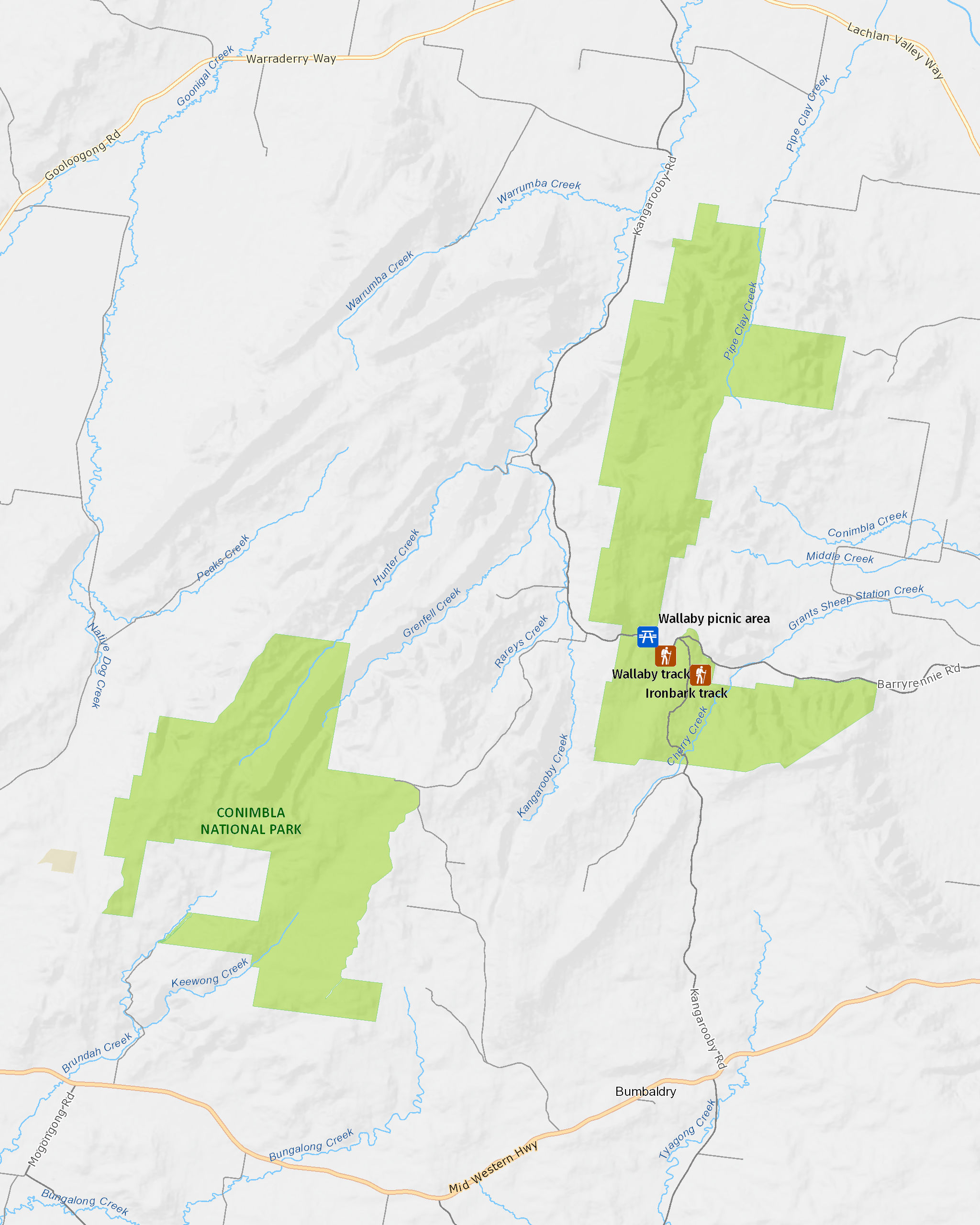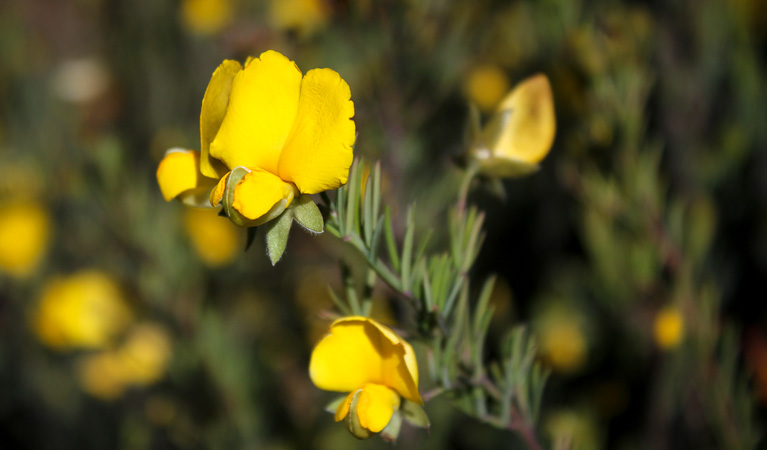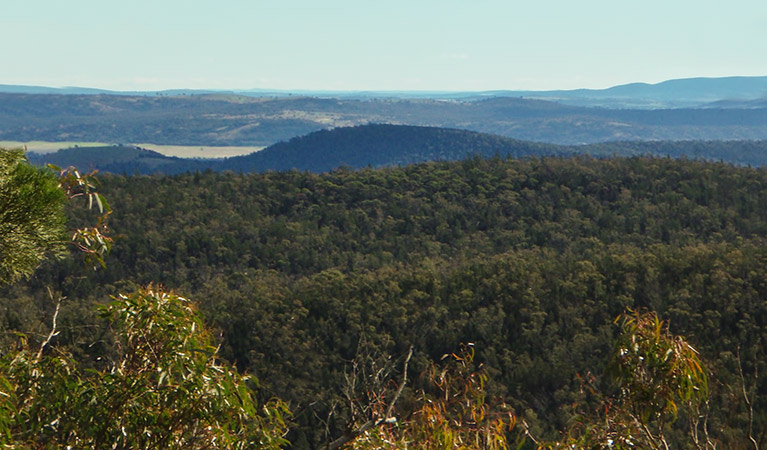Conimbla National Park
Overview
Conimbla National Park is a peaceful nature reserve that promises easy bushwalks, birdwatching and scenic views. It is located near Cowra, Grenfell and Gooloogong.
Read more about Conimbla National Park
A short drive from Cowra and Grenfell, Conimbla National Park is a quiet, tranquil nature reserve where you can enjoy easy, peaceful bushwalks amid rugged hills and farming country.
Yambira mountain and its surrounding forested ranges rise nearly 500m above the plain, forming a 'bush island' amid the central west farmlands. Rock ledges and small waterfalls have formed along some of the creek-lines. There is a large diversity of orchids in the park, including the only known population of the midge orchid, while many flowering shrubs brighten the landscape in spring, like flax lily, gold dust wattle, seven dwarf’s grevillea, myrtles, hill indigo, bitter peas, and grass trees.
The park is particularly popular with keen birdwatchers, as over 150 species have been recorded here, including some interesting threatened species, such as the little eagle, glossy black-cockatoo, turquoise parrot and several species of honeyeaters and robins.
Mammals you may see here include eastern grey kangaroos, wallaroos, swamp wallabies, little red flying foxes, brush-tailed possums, and the threatened pygmy possum and squirrel glider. Kangaroos and wallabies are often seen throughout the day, but the possums and gliders are best seen at night.
With limited visitors to this huge, untapped natural place, you can sometimes find that you have the entire 7,965ha of park entirely to yourself.
Local alerts
For the latest updates on fires, closures and other alerts in this area, see https://www.nationalparks.nsw.gov.au/visit-a-park/parks/conimbla-national-park/local-alerts
Contact
- in the Country NSW region
Conimbla National Park is always open but may have to close at times due to poor weather or fire danger.
-
-
Bathurst office
02 6332 7640
02 6332 7680 To contact the KARST Conservation Unit in this office.
Contact hours: Monday to Friday, 8.30am to 4.30pm. - Level 2, 203-209 Russell Street, Bathurst NSW 2795
-
Email: npws.centralwest@environment.nsw.gov.au
-
Bathurst office
Visitor info
All the practical information you need to know about Conimbla National Park.
Map

Map legend

Maps and downloads
Nearby towns
Cowra (25 km)
Cowra is gaining a reputation as a wine-producing region and source of specialty products. You'll find plenty of cellar doors where you can sample award-winning local wines from golden chardonnay to soft, ripe reds.
Canowindra (56 km)
In the red countryside of Canowindra, you can travel back 360 million years to see rare fossils in the amazing Age of Fishes Museum, where you'll encounter thousands of fossilised freshwater fish.
Grenfell (63 km)
The historic goldmining town of Grenfell is the birthplace of poet Henry Lawson, who was born on 17 June, 1867. Bushranger Ben Hall was also born nearby. Hall and his gang rampaged through the area from late 1863 until his death in a hail of bullets in May 1865.Visit the Grenfell Historical Museum to learn about Grenfell and its famous and (infamous) sons.
Learn more
Conimbla National Park is a special place. Here are just some of the reasons why:
A sanctuary for native plants and animals

Conimbla National Park is a large patch of vegetation surrounded by rugged farming country. The plants and animals here have had little disturbance in the last 40 years, making it an important reminder of vegetation native to the ranges and hills of central west NSW. Conimbla is particularly known for its diverse array of orchids, including the only known population of the beautiful and unusual midge orchid. In spring, the ground is covered with masses of beautiful wildflowers. Conimbla is also an important refuge for many birds, as it is the largest remnant of native vegetation in the local area and has a diversity of foliage, from open forest to heathland. A number of threatened species that have been recorded in the park have not been observed elsewhere in the surrounding farming country. With low visitation numbers, the park is incredibly peaceful, making it ideal for bird watching.
- Ironbark walking track Ironbark walking track in Conimbla National Park is a pleasant 1.5hr loop bushwalk with lovely scenic views, great birdwatching and wildflower photography opportunities.
- Wallaby walking track Wallaby walking track is a moderately challenging 3km return bushwalk linking Wallaby picnic area with Ironbark picnic area and carpark. Keep an eye out for red-necked wallabies and swamp wallabies along the way.
A peaceful bush getaway

Conimbla offers a quiet refuge for people as well. It's great for bird watching, bushwalking and heading off the beaten track to discover some of the park's hidden beauties. Wallaby picnic area is also an easily-accessed, tranquil spot to enjoy a picnic with family and friends.
- Wallaby picnic area Wallaby picnic area in Conimbla National Park features picnicking tables, and a spot for birdwatching in a lovely setting close to bushwalking trails and scenic views.
Education resources (1)
What we're doing
Conimbla National Park has management strategies in place to protect and conserve the values of this park. View the detailed park and fire management documents.

